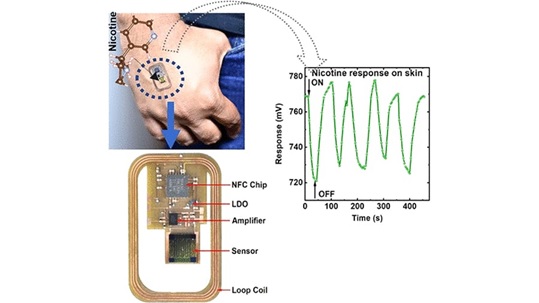Battery-Free Wearable Sensor That Measures Airborne Nicotine Exposure
As per studies by leading global health organisations, although smoking electronic cigarettes (e-cigarettes) is slightly less harmful than an ordinary cigarette, they nevertheless damage your organs, including the liver and heart. The main culprit is nicotine, a main constituent of e-cigarettes.
To quit the habit of smoking, many smokers resort to e-cigarettes without fully realising the adverse health effects of nicotine in them. Now, researchers from prominent Australian and U.S. research institutes have developed a battery-free, wearable device that helps such people know their limits in real-time. [1]

Figure 1. Battery-Free Wearable Sensor That Measures Airborne Nicotine Exposure
Figure 1 shows e-cigarettes are designed to heat and aerosolize a mixture of nicotine, glycerine, propylene glycol and flavoring additives, which the user then inhales. In the body, this mixture can affect multiple organs, including the respiratory system, where it alters airflow, increases oxidative stress and impairs immunity. In addition, nicotine exposure can lead to lung cancer. But assessing that exposure under real-world conditions has been difficult. Current assays for measuring ambient nicotine levels are carried out in laboratory settings and require large sample volumes and days to weeks of sampling. Portable nicotine sensors are being developed as an alternative, but the two that have been reported are impractical because they rely either on the presence of sweat or sunlight to function. So Madhu Bhaskaran, Md. Ataur Rahman and Philipp Gutruf set out to design a lightweight, wearable sensor capable of detecting nicotine in real time and sending the data wirelessly to electronic devices such as a smartphone.
The team chose vanadium dioxide (VO2) on a polyimide substrate as the basis for their sensor. They showed that nicotine can bond covalently to a thin film of VO2, thereby altering the film’s conductivity to an extent that depends on nicotine concentration. The device detects the change in conductivity, amplifies the signal and then transmits it wirelessly to a smartphone. When applied to skin, the battery-free sensor can measure the wearer’s exposure to vaporized nicotine in open air. The researchers say this approach expands the use of wearable electronics for real-time monitoring of hazardous substances in the environment. [2]
References:
- https://www.electronicsforu.com/news/whats-new/battery-free-wearable-sensor-that-measures-airborne-nicotine-exposure
- https://scitechdaily.com/battery-free-wearable-sensor-measures-airborne-nicotine-exposure-from-e-cigarettes/
Cite this article:
Thanusri swetha J (2021), Battery-Free Wearable Sensor That Measures Airborne Nicotine Exposure, pp. 37

